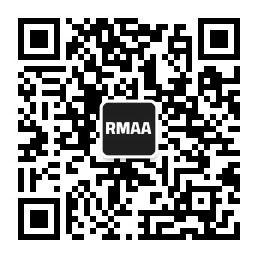Blog about successful marketing strategies in russia
Top Russian Social Media Platforms for Advertising and Engagement

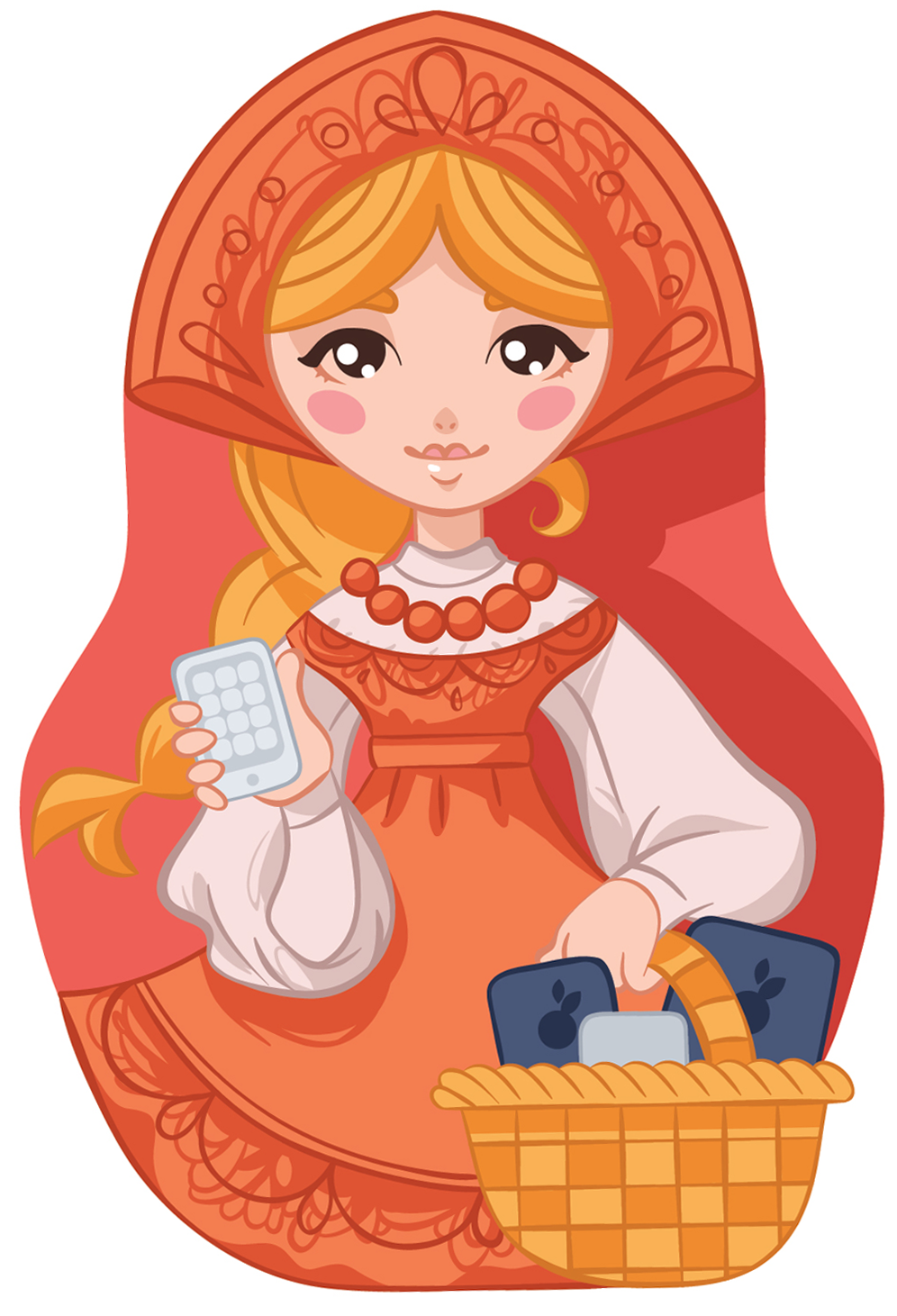
DIGITAL MARKETING
Share this Post
In today's digital landscape, where competition is fierce on popular online platforms, it's crucial to have flexible and adaptable advertising strategies. This means considering not only large digital platforms but also more specific or specialized resources. These can offer unique opportunities for narrower targeting and direct interaction with the target audience as well as provide low competition.
In 2024, when well-known social networks are already maxed out, less traditional channels of promotion will be the new frontier for successful campaigns. And they'll save you money on your marketing budget.
TOP Social Media in Russia
Several major platforms continue to dominate the Russian online space, each with its unique features and audience. Nearly 47% of users’ time on the internet is spent on social media.
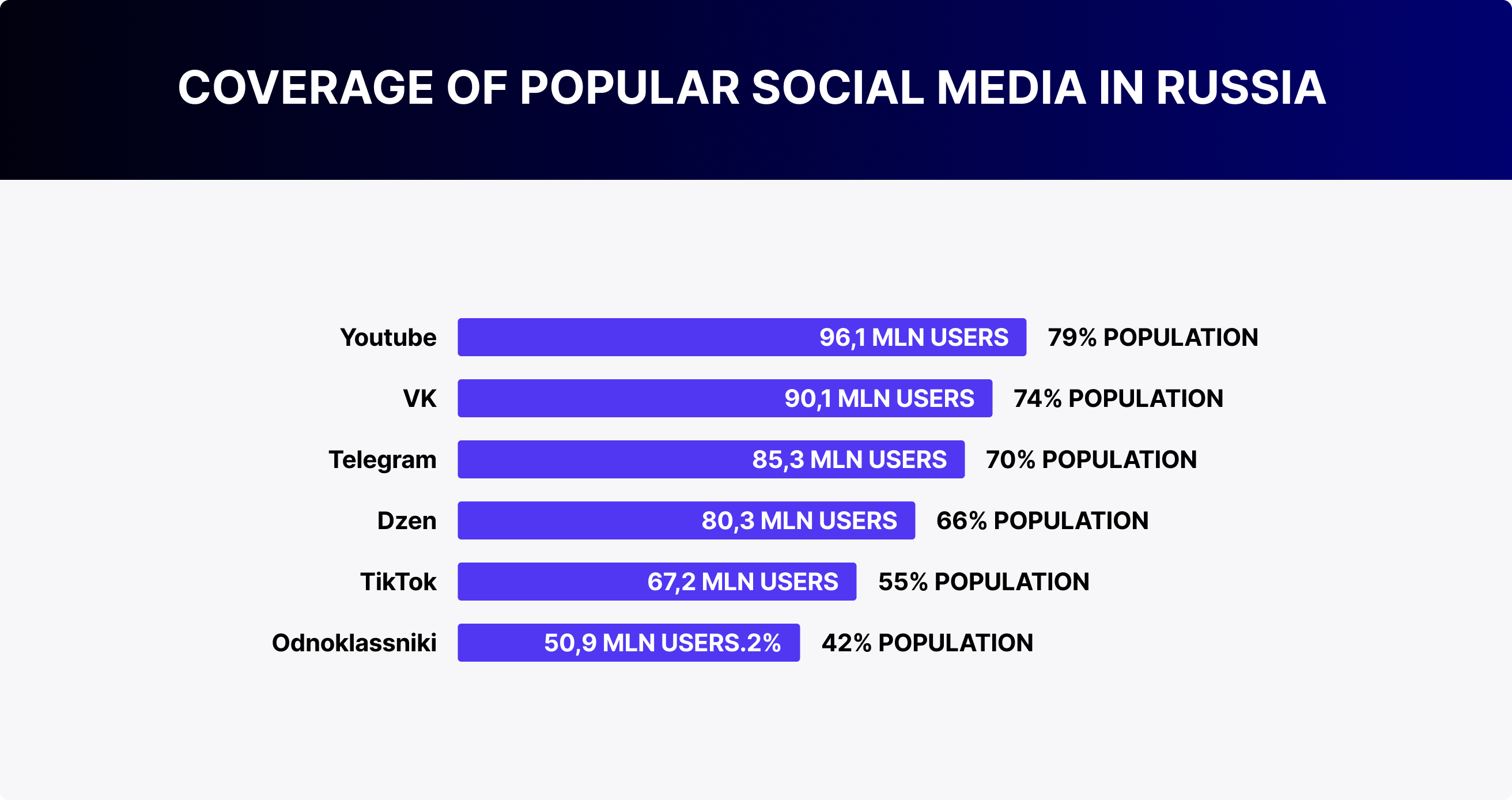
YouTube
It is the most popular video service in Russia today. This format is the ideal way for companies to demonstrate products and services in the most visual format, tell stories, share expert opinions, organize live broadcasts of events, and even hold webinars. In addition, there are also shorts — incredibly popular short vertical videos.
Genshin Impact advertising collaboration with YouTube blogger FixEye (11.1M subscribers), by RMAA
One of the main advantages of YouTube on the Russian Internet is its wide audience, covering various age groups and interests. Although promotion opportunities through the platform itself are now limited, brands advertise in videos on other channels. This is the main and most effective method of marketing their products and services.
Service coverage - 96.1 million people (79% of the population)
VKontakte
It is the most popular platform in Russia with a wide range of functionality. It's the most convenient one for developing both personal profiles and communities, which you can promote using the built-in marketing instruments. VK offers the best set of tools for promotion, including paid social, groups, and video advertising.
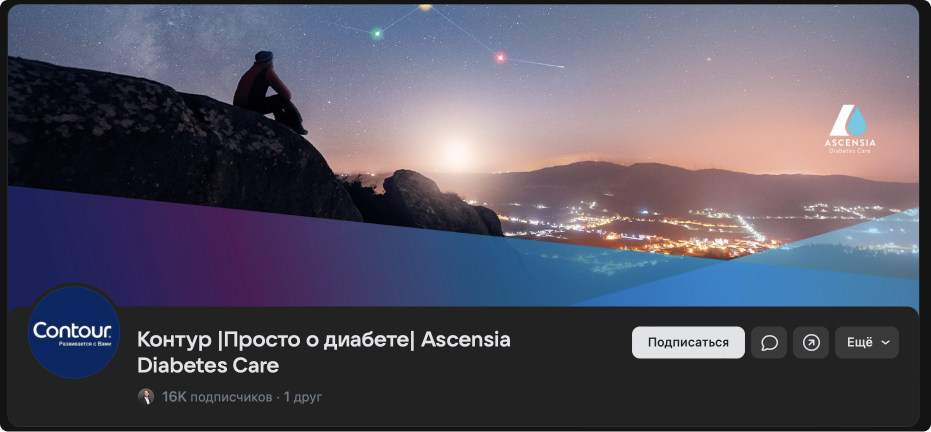
The official VC community of the Ascensia Diabetes Care brand, by RMAA
Telegram
The messenger with ever-expanding features that is taking over the market. It's as simple as the app itself. While paid social is expensive, it is an effective and affordable strategy when placed through agencies. The use of integrations with bloggers and channels as well as bots remains a popular approach.
The service reaches 85.3 million people, which is 70% of the population. On average, 74% of users read Telegram channels, and more than half of them cover news and politics.
TikTok
The video platform that young audiences love. It was one of the first to offer viral content to users and creative advertising formats to advertisers. Marketers use it to reach even the narrowest audience.
The service reaches 67.2 million people (55% of the population).
Odnoklassniki
It is the go-to platform for a more mature audience looking to socialize and connect with like-minded individuals in themed communities. It offers unparalleled opportunities for video, text content, and paid social.
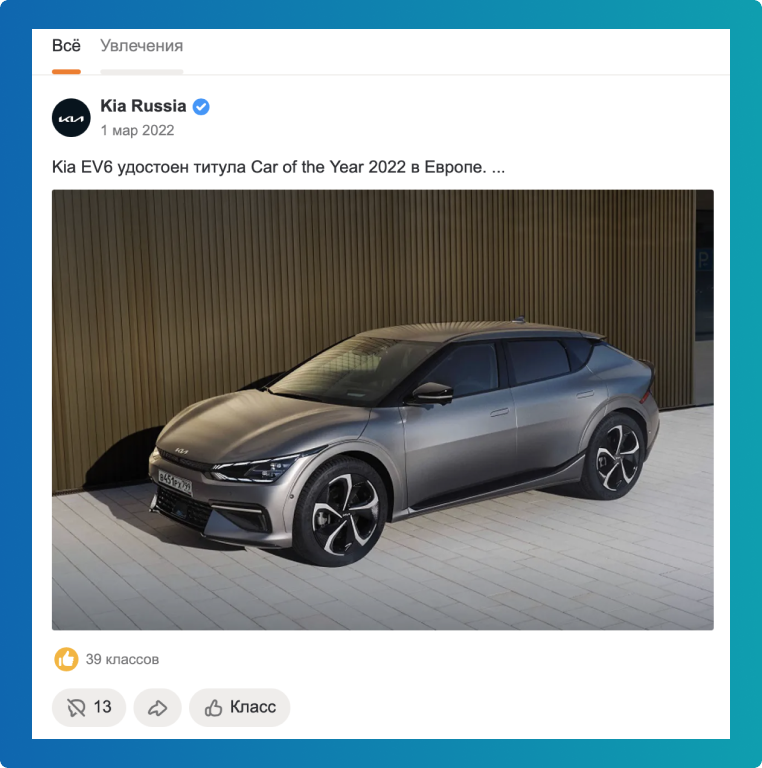
A post in Kia Russia OK Community
Service coverage - 50.9 million people (42% of the population)
Instagram*
Despite the limitations imposed by restrictions and sanctions, Instagram* remains a popular platform. Its visual focus is particularly well-suited to brands with a strong external component. Furthermore, the platform's most significant genre, reels, can facilitate reaching a vast audience (if the video creation process is approached in an optimal manner). Starting September 1, 2025, advertising on Instagram will be officially banned in Russia. The only way to continue will be user-generated content, without links, branded elements, or direct mentions.
OPU brand advertising on @irena_ponaroshky Instagram profile
At the end of 2024, the average monthly audience of the service in Russia was 25.1 million people.
Twitch
One of the leading video game streaming platforms, has a long-standing and significant presence in Russia. However, it is now attracting not only gamers but also viewers with an interest in entertainment and educational content. Moreover, an increasing number of businesses are utilizing Twitch as a promotional platform, engaging in sponsorship, channel creation, and video ad insertion. These businesses are primarily in the gaming, gambling, food, tech devices, e-commerce, online services, and other technology sectors.

Twitch account of Russian gamer Nix (798K subscribers)
As evidenced by data from March 2024, the platform has facilitated the placement of over 500 advertising publications. Russian companies employed over 300 influencers for promotional purposes, with advertising reaching 35 million unique viewers.
We have previously published a separate article on the distinctive features of promotion on the leading social networks in Russia. However, in some cases, these platforms may not be the optimal choice for reaching the entire consumer base of a brand. There are alternative avenues where it is possible to connect with consumers, both existing and prospective.
Alternative Social Networks in Russia
While these services may be less well-known, they present valuable opportunities for promotional activities.
Discord: Building a Community, Not Just an Account
Originally launched as a messenger for gamers, by 2025, Discord has evolved into a full-fledged community hub, uniting everyone from IT professionals and online course participants to brand fans and niche interest groups. This isn’t a platform for chasing reach. It’s where you build tight-knit relationships with audiences who want to be ‘on the inside’.
It’s worth noting that Discord was officially blocked in Russia in 2024. Still, just like with Instagram, users continue to access it via VPN. The most active users remain gamers, digital professionals, and online learners — people who’ve already integrated Discord into their daily routines.
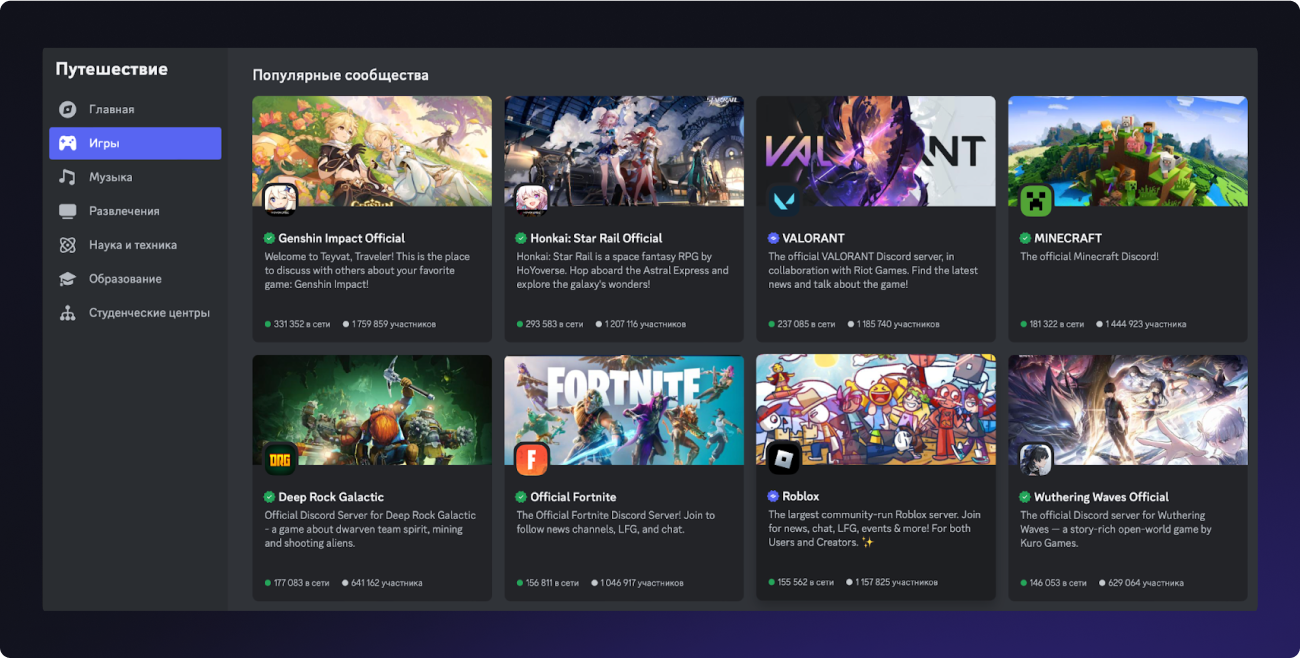
Unlike traditional social platforms, Discord doesn’t run on scrolling. It’s not about viral content or paid reach. It’s a micro-environment where a brand speaks directly to users. Channels can be customized for any purpose: customer support, private webinars, product announcements, general chat, leveling systems, custom roles, auto-responders, bot integrations, and CRM connections.
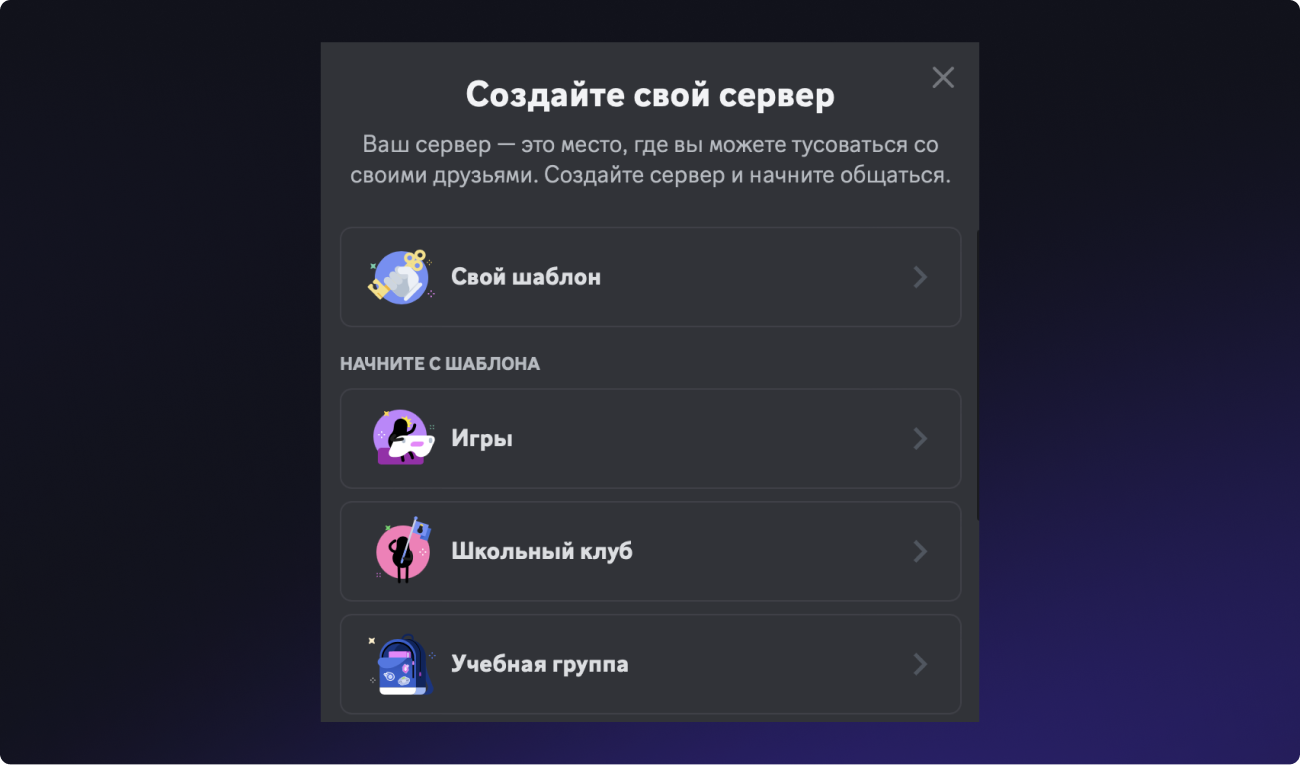
The platform offers more interaction formats than Telegram and deeper customization than any messenger. It’s a space where loyal customers can be gathered into a club, learners can transition into a lasting community, and brand fans can connect without the noise. Especially if your brand has regular updates, a complex product, or a service component, Discord helps maintain engagement between purchases.
It works best for digital companies, education projects, SaaS brands, IT services, and anyone selling not just a product, but a system, an experience, or an ecosystem. You can launch beta access, share insights, and collect feedback, all in real time, without the overhead of formal campaigns.
Even FMCG brands occasionally enter Discord, but only when they have a clear purpose. If a brand understands that this isn’t about the ‘mass consumer’ but rather the active core audience, the platform can deliver results, especially with gamers, who won’t respond to banners but will engage with the right mechanics.
One FMCG brand did exactly that in a campaign with Twitch and Discord, developed by the Uplify agency. Instead of relying on traditional ads, a chicken nugget brand embedded itself in gaming culture: they launched a branded Discord server, kicked off a quest with rewards, and designed a ‘keys for activity’ system. Users earned virtual keys by completing tasks, joining streams, and participating in discussions, and could then exchange them for real prizes.
The server became a true hub for interaction, not just another ad channel. The brand integrated into the community: people played with it, talked to it, and engaged in real dialogue. The audience was genuinely involved. The campaign hit 100% VTR, generated 4 million views, and reached a CTR of 1.06% — more than double the industry average.
Discord is worth using when your goal isn’t just to sell, but to create lasting engagement. It’s not an ad tool. It’s a connection infrastructure that keeps working while other platforms compete for attention.
Dzen: Text and Video with Smart Content Delivery
Dzen isn’t a classic blog platform or social network. It’s a recommendation engine designed to show content that’s most likely to resonate, regardless of how many followers a channel has. The feed is based on user behavior, not subscriptions. That’s why even an unknown channel can generate tens of thousands of views if it hits the right interests.
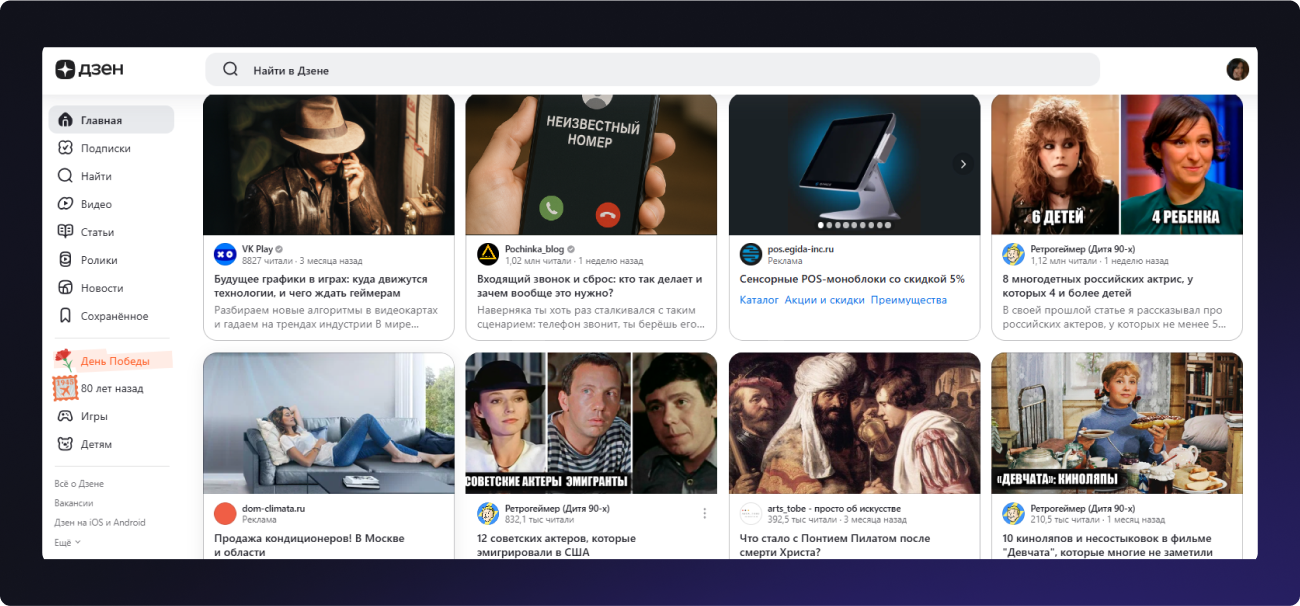
As of early 2025, Dzen's audience exceeds 80 million users. Its core base is 25+, with particularly active segments in the 30–44 age range. This is a mature, solvent audience that spends significant time on the platform, reading curated selections, watching videos, and clicking on content cards. Popular topics include health, style, food, finance, travel, tech, product reviews, and practical guides.
For brands, this means one thing: if you’re capable of telling engaging stories, not just selling, the platform will work for you. Content that delivers practical value, has an expert tone, and uses soft engagement performs best. Aggressive advertising burns out quickly here. But reviews, advice, and explainers like ‘how to choose’ or ‘what you should know’ can drive high-quality traffic at just the right moment, when the user is already interested.
Promotion is handled through VK Ads, a user-friendly dashboard that allows you to manage creatives, launch campaigns, and target by topic, interest, location, and device. The entry cost is moderate, and with the right content, you can achieve high CTRs at a reasonable spend.
Dzen is ideal for warming up a cold audience and communicating product value without pressure. It’s not a space for hard-sell banners, but rather a platform for native expertise. It’s especially effective if the brand already has existing content, such as articles, video tutorials, or expert opinions, that can be adapted.
For example, the cosmetics brand MIXIT runs its Dzen channel, publishing articles like ‘Why Bifidobacteria Matter in Skincare’ — with no hard promo, but subtle product integration. This kind of content gets picked up by recommendation feeds and generates steady organic traffic without a budget. The brand also produces video content in the same style, such as ‘How to Quickly Reduce Puffiness at Home,’ again embedding products seamlessly into the narrative.
Why does it work? Dzen’s audience is adult and highly engaged. If the content is useful, people read it to the end, watch it fully, and click through. One of the most effective formats is ‘how-to + expert opinion’, combining instruction with credibility.
VK Clips and Yappy: Fast Formats for a Young Audience
Short vertical videos have become a full-fledged advertising channel with consistent results, especially in Russia, where TikTok is losing ground while local platforms grow by being better integrated and more tailored to domestic audiences.
VK Clips is part of the VKontakte ecosystem. Integrated directly into the main feed, it doesn’t require users to switch between apps: videos play natively, launch automatically, and are easily liked or shared with a couple of swipes. For advertisers, it connects seamlessly to VK Ads, offering campaign management, targeting, analytics, and scalability. The barrier to entry is lower than for traditional video ads, and most importantly, organic reach performs well if the format is done right.
Why does this work?
The videos are part of VK’s core feed, which increases the likelihood of being seen. The platform provides native analytics on reach and clicks. The format acts like a teaser — light, visual, and engaging without overwhelming the viewer.
Yappy is a different story. Originally conceived as a TikTok alternative, it remains under the radar — and that’s its strength. There’s almost no competition, few brand presences, and anything well-executed gets noticed. Its audience is primarily teens and young adults under 25. The dominant styles are challenges, quick takes, humorous content, and collaborations with local content creators.
Instead of presenting itself as a ‘platform for everything’, Yappy is carving out a cultural niche. This was evident in its early 2025 campaign with influencer Vlad Glent, shot in hyperpop style — fast cuts, genre mashups (anime, ASMR, beauty, life hacks), and intense visuals. The campaign ran across TV, universities, schools, billboards, and notably, on Europe’s largest vertical media facade in Moscow. Offline events in cities like Kazan and St. Petersburg supported the push.
Yappy is also experimenting with gamified formats. Two years ago, it launched a virtual city called Yappy Universe inside Roblox — a full-on metaverse with quests, branded zones, livestreams, and promotional events.
The platform is great for promotional activations and special projects, as long as they don’t look like ads. Yappy is made for native presence, not hard-sell offers. Its advantages are low cost of entry and high visibility with the right creative. The downside? No mature ad manager or official analytics tools. Everything requires a hands-on approach: negotiating directly, customizing content, testing manually.
Yappy encourages collaborations with already active creators. Content that feels organic, not promotional, is more likely to make it into recommendations. The platform is ideal for challenges and UGC integrations.
One example: Sharme launched a video with @tatiana_greenway — a visual tutorial delivered in a personal, emotional style. No voiceover, just text and expression.
Both platforms are especially useful when the goal is to quickly present a product, test a hypothesis, or engage a younger audience in an interactive format without major media spend. They’re a good fit for brands not ready to commit to high-cost influencer deals but capable of producing short-form content in-house.
Likee: When Engagement Matters More Than Format
In Russia, Likee is often overlooked and unfairly so. While the platform has never been top of mind, it has maintained a steady presence in the short video niche, with a focus on entertaining, visually driven, and often deliberately flashy content. At one point, up to 31% of Likee’s global audience came from Russia. While no official figures are available now, user activity hasn’t disappeared, especially among those under 30.
The formats are standard: vertical videos, livestreams, and slideshows. But what makes Likee stand out is its use of unique filters, visual effects, and engagement mechanics that resemble early TikTok energy. The key difference is that Likee’s algorithm favors not creators with massive followings, but new content with strong engagement. New accounts that are set up properly — with a complete profile, consistent posting, and original videos — can gain traction through organic reach.
For brands, the platform offers a compelling channel to launch visually bold products. It’s not about narrative, it’s about visual impact. A well-shot, effects-heavy clip, a staged moment, or a wow-factor challenge works. A dry product demo doesn’t. Likee still allows brands to ‘catch a wave’ and reach a young audience without months of buildup.
It’s especially well-suited for those already producing video content for Reels or TikTok and looking to test an alternative algorithm with less competition. It also fits perfectly with image-driven categories like gaming, fashion, beauty, food, home decor, gifts, and lifestyle.
For example, in December 2024, Genshin Impact launched a major cosplay event on Likee named Together with Mavuika. Users posted short videos in costume, used AR effects and hashtags, and participated in giveaways for figurines and in-game prizes. The content was regularly featured in curated feeds, widely shared, and heavily commented on.
More importantly, the campaign extended beyond the platform. In January 2025, an offline event took place at Moscow’s Riviera Mall, where everyone could record a video on-site, upload it to Likee, and receive a promo code instantly. The event featured interactive stations, photo zones, giveaways, and live performances. TECNO Russia was the equipment partner.
This wasn’t just a brand ‘showing up’ on Likee. It was a targeted engagement with a youth-driven, visual-first audience for whom Genshin represents an entire immersive world. The campaign generated tens of thousands of videos, landed in recommendation feeds, and most importantly, drove participation, not through banners, but through interaction.
Why does it work? The platform prioritizes visual engagement over explanation. If a brand can make it ‘look good’, it earns attention. Younger audiences respond to interaction, not instruction.
TenChat: An Alternative to LinkedIn
If LinkedIn is the global career showcase, then TenChat is the platform for doing business and building a professional reputation within Russia. It blends elements of a social network, messenger, media outlet, and expert community. And while the interface may feel cluttered, the platform is steadily evolving into a fully-fledged B2B environment with its logic and an active user base.
As of 2025, 89% of TenChat’s audience is based in Russia. The core demographic is professionals aged 25–45, with strong representation from IT, marketing, media, finance, and education. This is an audience that reads, reflects, and shares ideas. What works here isn't memes, but expertise, case studies, behind-the-scenes stories, and in-depth analysis. Articles styled as personal blogs by CEOs or editors-in-chief often outperform official branded content in terms of reach.
TenChat’s internal algorithm is admittedly picky. It dislikes outbound links, overt advertising, or empty posts. But if you follow the basics — a well-designed profile, honest storytelling, and consistent posting — you can tap into strong organic reach. The platform rewards transparency, open conversation formats, and a human tone.
You should consider using TenChat if your goals include building a local professional reputation, strengthening your employer brand, finding partners, testing B2B hypotheses, launching niche media projects. This isn’t a mass-reach channel, and it’s not about numbers at any cost. But if your goal is to become a recognized voice in the Russian business community, TenChat is the place to be.
For example, X5 Group regularly shares updates on TenChat, including project launches, interviews with top executives, and behind-the-scenes content from within the company.
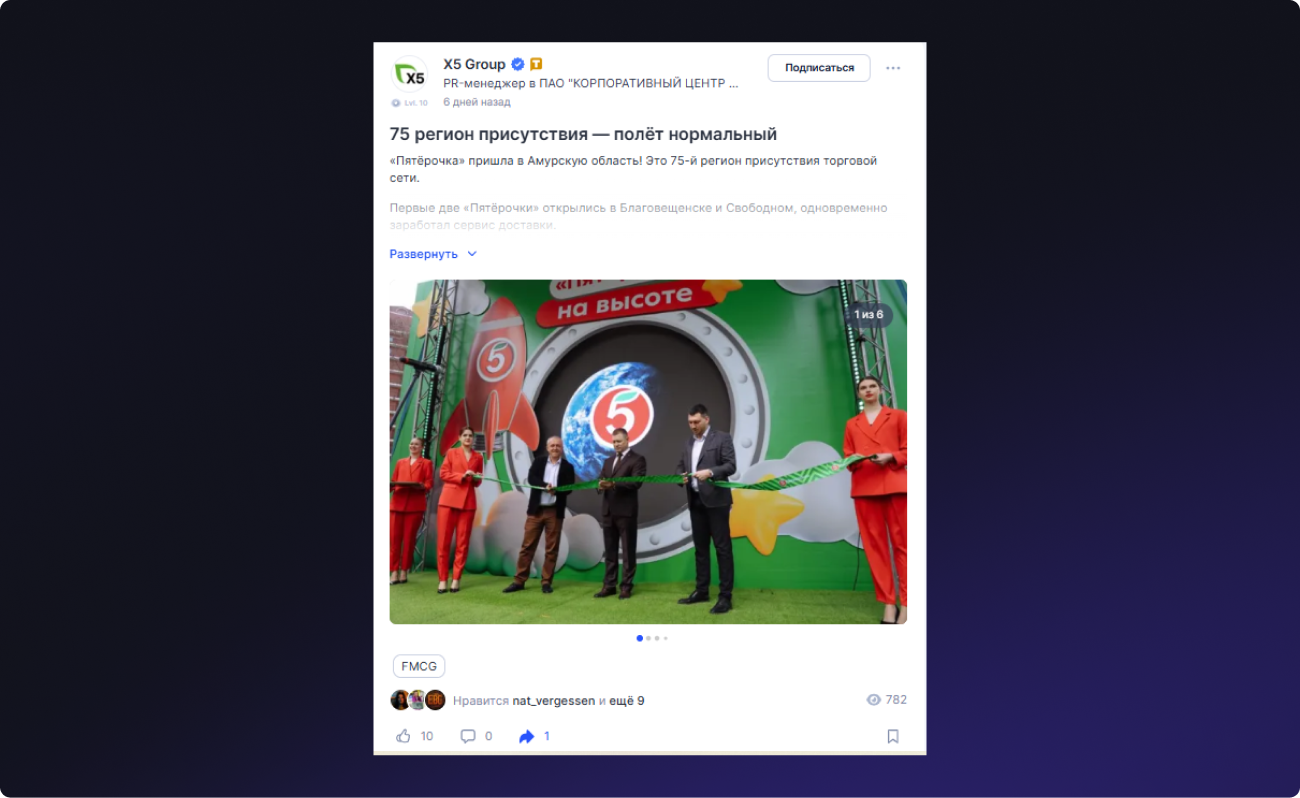
A small brand producing handcrafted door handles entered the platform from scratch, with no advertising budget. They chose to grow entirely through organic tactics and focused right away on a B2B audience: dealers and suppliers.
The strategy centered on direct engagement — actively liking, commenting, and messaging potential clients. To stand out, they offered a creative incentive: a free showroom display stand with any handle order. This offer acted as a trigger for those who had been looking for a stylish presentation solution.
The result? In just one month, the account gained 240 followers and generated 12 qualified leads, all without spending a single ruble on paid ads.
Why does it work? The platform is tailored for expert storytelling and authentic employer branding. Accounts that show a face, offer context, and provide value get 10–15 times more reach than those simply reposting press releases.
Is It Worth Experimenting with LinkedIn?
Officially, LinkedIn has been banned in Russia since 2016. But in practice, it’s still widely used through VPNs, accounts registered abroad, or browsers that bypass restrictions automatically. For the B2B segment, it remains one of the key international storefronts, especially if you’re working with markets in the CIS, Asia, or Eastern Europe.
In 2025, LinkedIn isn’t about traffic or direct conversions. It’s an image-building space. People don’t read posts from brands — they read posts from people. Personal profiles, particularly those of employees, have become trusted communication channels. What performs best is case-based content, contributions to industry discussions, niche group participation, and consistent posting from CEOs, managers, developers, or consultants.
If your plans include expanding beyond the Russian market, LinkedIn becomes an essential part of the strategy. It’s useful for maintaining an international reputation, networking, and finding partners and experts. It won’t drive direct sales in Russia, but it will strengthen your brand's credibility in any interaction with a global audience.
It makes sense to be on LinkedIn if:
– You have team members ready to manage personal profiles in English or relevant local languages (e.g., for Kazakhstan, Poland, the UAE); – You understand LinkedIn is about playing the long game, not about quick leads.
For example, many Russian companies now use LinkedIn as a tool to enter international markets, particularly in B2B. One standout case involved a manufacturer of colored separators. Their team reached out to international distributors through the personal profile of their international sales director.
Here’s how it worked:
They launched with no ad budget, just manual outreach. They set up Sales Navigator, prepared scripts, and began targeted messaging. Over four months, they sent 1,200 connection requests, received 283 accepts, and got 40 warm responses — all passed on to the sales team. At the same time, they created a company page, joined 20 professional groups, and trained their team on LinkedIn best practices.
This case is notable not for the industry, but for the method. It shows that with clear positioning, a Sales Navigator, and someone willing to drive personal outreach, LinkedIn can genuinely function as a market-entry channel.
If a Russian sales director can reach distributors in Asia or Latin America, then a foreign brand can just as effectively find Russian partners or clients, as long as they speak the same language or understand the local context.
LinkedIn is worth exploring if you're in B2B and building a brand meant to exist beyond Telegram. It’s not a sales channel per se, more of a long-term touchpoint and a way to attract top talent and strategic partners.
For instance, Sber is one of the few Russian brands that has maintained a public presence on LinkedIn. The company regularly posts about tech initiatives, job openings, international collaborations, and ESG initiatives.
A Sber's post about looking for IT specialists to develop the AI assistant GigaChat on its corporate LinkedIn account.
This approach helps position Sber as a global-facing company, even amid restrictions. It keeps ties with external partners, investors, and the expat community, while also managing reputational risks in the English-speaking space, where platforms like VK or Telegram don’t have reach.
Fast Insights
Alternative platforms aren't a backup plan or a second-best option. They’re tools that can deliver faster, cheaper, and more precisely, if used with intent. You don’t need to choose either Telegram or Likee. And jumping from VK to Discord, hoping to find a miracle audience with zero effort, doesn’t work.
A solid strategy in 2025 is built on the combination. Telegram delivers reach and instant reactions. Dzen acts as a warm funnel — it informs, nurtures, and builds trust. VK Clips connects with those who don’t read or click — but do watch and remember. TenChat builds expertise in professional circles. Likee and Yappy generate short-term buzz among younger users. Discord retains the already engaged. LinkedIn gives your brand a voice beyond the borders.
And most importantly, it’s time to stop thinking in terms of ‘where we have more followers’. That’s no longer a real measure of effectiveness. What matters is relevance, context, and how your channels work together. Who you are, whom you're speaking to, through what, and at what moment. That alignment drives response, not the numbers on a reach graph.
Today, a good strategy isn’t about chasing noise. It’s about finding the space where you’ll be heard and speaking with purpose.
If you're looking to enter the Russian social media space without trial and error, we’re ready to help.
We track what actually works in 2025 and will build a custom channel mix for your specific goals. No guesswork. No templates. Just clear outcomes.
If you need a partner who understands how the Russian audience really works, leave a request below. Let’s discuss your objectives and find the formats that deliver.
*Meta's activities are banned on the territory of the Russian Federation.
Join 2,000+
of your Peers!
You will be the first to know about Russian marketing insights, news and updates from our agency. Stay tuned!
Get our latest articles delivered to your email inbox and get our exclusive White Paper
"Digital Marketing in Russia. Finding your customers on the internet"
for FREE!
Russian Digital Market Overview
Strategic Insights into Russian Digital Marketing Landscape
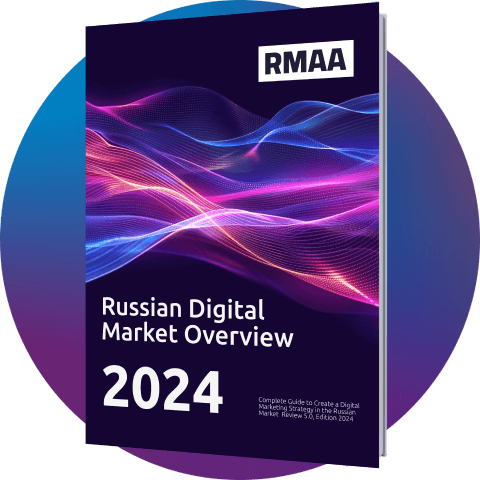
Ready to partner with the specialists in Russian marketing and advertising?
About the Author
Digital Strategist. Head of one of the project groups at RMAA. Maria started her journey in digital marketing in 2009.
Join 2,000+ of your Peers!
Get our latest articles delivered to your email inbox and get our exclusive White Paper "Digital Marketing in Russia. Finding your customers on the internet" for FREE!
You will be the first to know about Russian marketing insights,
news and updates from our agency.
Stay tuned!
We're updating our website's design step by step, so some pages may look different. Thank you for your understanding.
Got it








